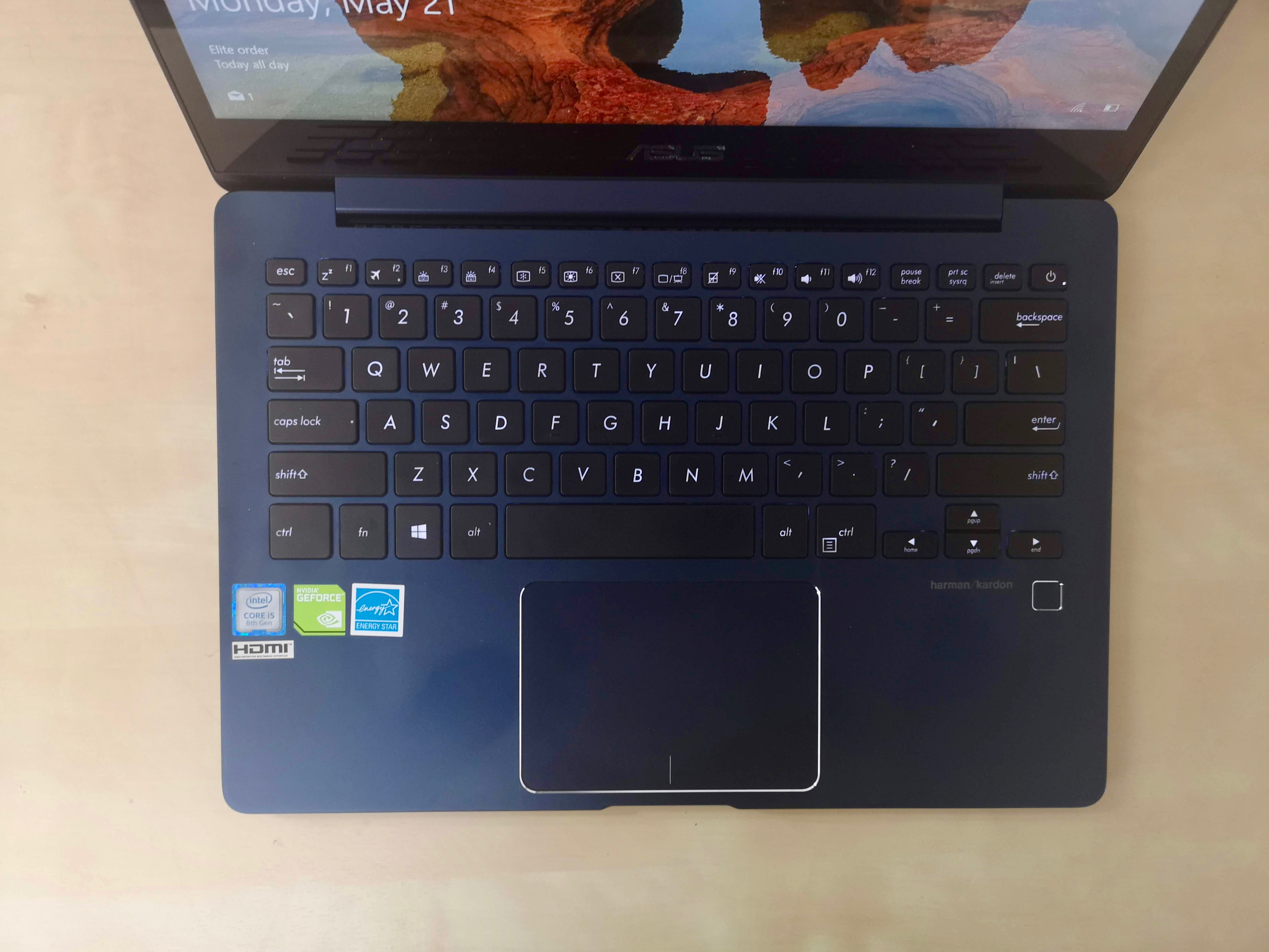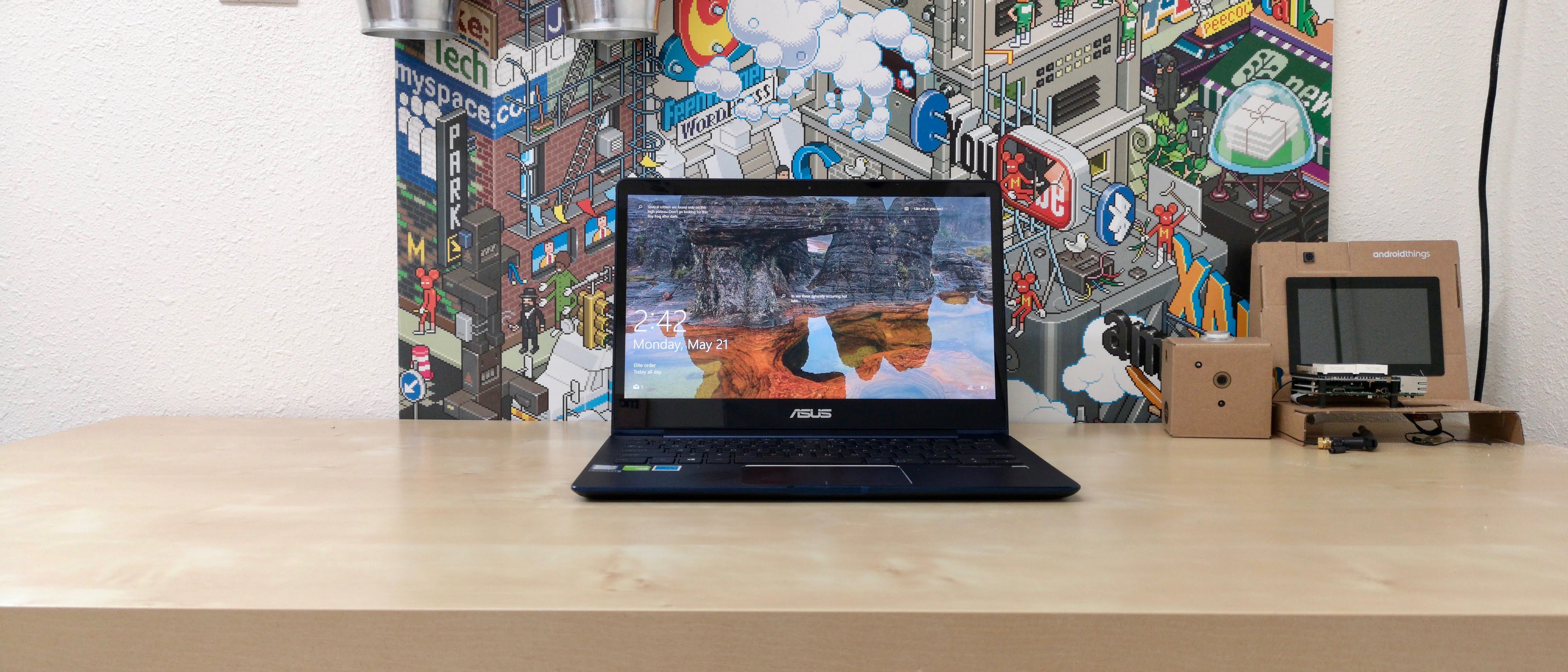TechRadar Verdict
The latest ZenBook 13 from Asus isn’t a speed demon, but it has a killer display and a keyboard that’s as smooth as butter. Plus, it finally addresses a key bugbear in Asus’s laptop design.
Pros
- +
Decent battery life
- +
Fast fingerprint sensor
- +
Stellar display
Cons
- -
Janky touchpad
- -
HDMI port should be USB-C
- -
Shell is a smudge magnet
Why you can trust TechRadar
Hauling around a laptop that’s impressively lightweight and thin, while still packing powerful components, can be a great feeling. Knowing you have a powerful tool in your backpack or briefcase is reassuring – even more so when that tool doesn’t cost a couple grand.
Just take a look at the Asus ZenBook 13, for example. Packing Intel’s latest Core i5 processor and an Nvidia GPU, while still being more affordable than the MacBook Pro or the latest HP Spectre 13, it sits among the best Ultrabooks. Heck, it’s the same price as the Dell XPS 13, but with slightly better hardware inside – but, we’ll get into that later.
Here is the Asus 13 ZenBook UX331UN configuration sent to TechRadar for review:
CPU: 1.6GHz Intel Core i5 8250U (quad-core, 6MB Cache, up to 3.40GHz with Turbo Boost)
Graphics: NVIDIA GeForce MX150 (2GB DDR5 RAM), Intel UHD Graphics 620
RAM: 8GB LPDDR3
Screen: 13.3-inch, FHD (1,920 x 1,080) wide view touch display
Storage: 256GB SSD (SATA3)
Ports: 1 x microSD card reader, 1 x 3.5mm combo audio jack, 2 x USB 3.0 Type-A, 1 x full-sized HDMI, 1 x USB 3.1 Type-C
Connectivity: 802.11a/c Wi-Fi, Bluetooth 4.2
Camera: VGA webcam
Weight: 2.5 pounds (1.12 kg)
Size: 12.2 x 8.5 x 0.5-inches (310 x 216 x 13.9 mm; W x D x H)
Price and availability
If you’re in the market for the latest ZenBook 13, you won’t have any options to customize the internals in the US. The $999 (£899, about AU$1,320), price tag gets you the modestly configured laptop you see here.
In the UK, the same model we tested is £899, with a more powerful model featuring a an Intel Core i7 and double the storage will set you back £1,299.
Comparatively, a similarly spec’d HP Spectre 13 starts at $1,149 in the US, or in the UK the Spectre 13 doubles the storage and a 4K display for £1,599.
Apple’s MacBook Pro far exceeds the price point of the ZenBook 13, and is stuck with last generation Intel processors.
We recently took a look at the new Dell XPS 13, priced at $999 (£1,299, $2,299), but without a touch-screen, half the RAM, and half the amount of storage found on the ZenBook 13. All in all, the ZenBook 13 is competitively priced for what it offers.
According to the Australian Asus website, the ZenBook 13 is available across a long list of retailers, however we’ve failed to find a retailer with any stock.
And, if you’re looking for a deal on the Asus Zenbook 13, you can find it used on B&H Photo and Video in the US, rocking the same configuration we tested here for just $850 (about £641, AU$1,138).

Design
The next time you find yourself frantically looking for a mirror to ensure your hair looks good, just close the lid of the ZenBook 13. It’s not only shiny, but reflective enough to serve as an impromptu mirror for you or your classmates. We tested the royal blue model, but the slate gray model looks just as reflective and shiny.
There are a number of ports on the ZenBook 13. On the right side is a microSD card reader, a 3.5mm headphone jack, and a USB 3.0 port. On the opposite side is where you’ll find a USB Type-C port, another USB 3.0 port and a full-sized HDMI port.
It’s that last port that has us a bit puzzled. Indeed, it’s convenient to have the option to connect smaller laptops such as the ZenBook 13 to external monitors, but we can’t help but think using that space for another USB-C 3.1 port would be far more beneficial than an HDMI port.
A standard keyboard is backlit with a white light and several levels of intensity. The chiclet keys offer 1.4mm of travel and is incredibly comfortable to type on. We use a lot of keyboards, and most take some sort of adjustment before we really get into a flow. With the new ZenBook 13’s keyboard, however, it was love at first type.
The 13.3-inch display is surrounded by 6.8mm Asus’s NanoEdge bezels. The touch sensitive display is smooth and responsive to our fingers. We didn’t have an Asus Pen to test on this particular unit, but that is an option with the ZenBook 13 should you want a stylus for jotting notes and drawing. One thing to note, however, is that the hinge does not let the display fold flat, so you’ll have to adjust to drawing with the screen in a standard laptop-like orientation.
Even though the display is FHD (1,920 x 1,080), it’s incredibly sharp and leaves the impression of being of a higher-resolution.

Fingerprint sensor is finally in the right place
Thankfully, Asus has come to terms with the fact a fingerprint sensor does not belong on the touchpad. We’ve long complained about having to work around an Asus fingerprint reader in the top-right corner of the touchpad, making it awkward to move documents around or use gestures.
The fingerprint reader now sits just below the right arrow key, and is far more convenient to use. Thanks, Asus.

Let’s talk touchpad
With the fingerprint sensor out of the way, this is the first time we’ve had a change to truly get a feel for an Asus touchpad. The touchpad works with gestures, but almost too well.
When using two fingers to scroll down a webpage, we often accidentally trigger the zoom function in Google Chrome. The gestures are different enough (two finger swipe and pinch-to-zoom) that we are a bit puzzled by the mixup.
